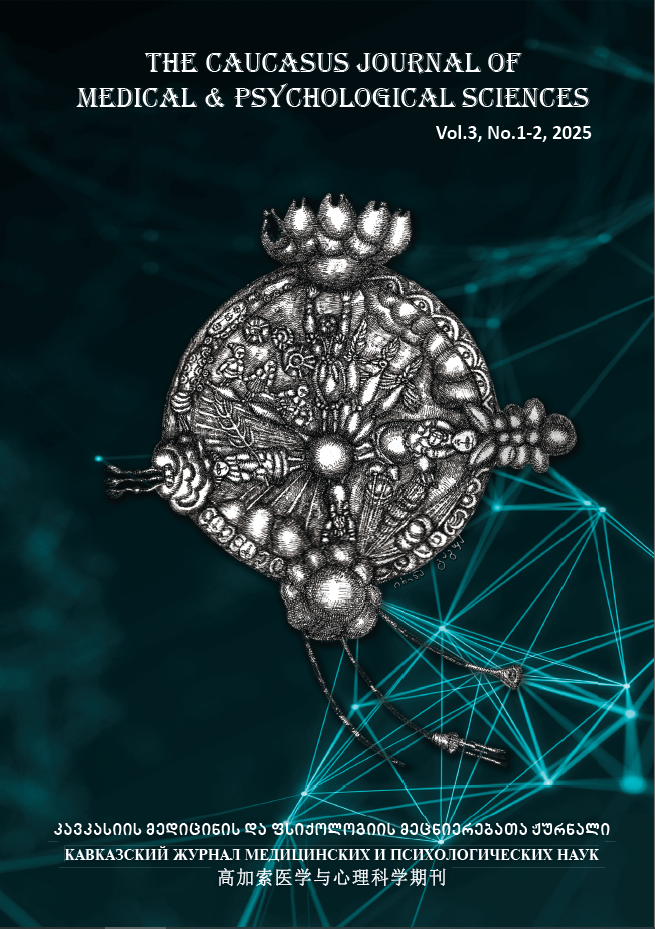Spastic Diplegic Cerebral Palsy: GMFM88 in Children Before and Two Years After Physical Rehabilitation
DOI:
https://doi.org/10.61699/cjmps-v3-i1-2-p1-18Keywords:
cerebral palsy, spastic diplegia, physiotherapy, rehabilitation, GMFM-88 scaleAbstract
The study aimed to assess gross motor function in children with spastic diplegia – the second most common form of cerebral palsy (CP) – before and after two years of physical rehabilitation by means of conventional physiotherapy interventions. The study was conducted at the Ken Walker University Clinic of Medical Rehabilitation (Georgia, Tbilisi) among 31 children with spastic diplegia aged 5 to 12 years old (inclusive). The functioning of the clinic is supported within the framework of a project funded by the United States Agency for International Development (USAID), the goal of which is to develop physical rehabilitation in Georgia (Tbilisi).The specialists have undergone full professional education and training under the guidance of experts from the Emory University School of Medicine. The children with spastic diplegia were divided into four age groups: group aged 5 – 6 consisted of 8 patients; group aged 7 – 8 consisted of 8 patients; group aged 9 – 10 consisted of 8 patients; group aged 11 – 12 consisted of 7 patients. The level of the child’s ability was assessed in accordance with the Gross Motor Function Classification System. The Gross Motor Function Measure (GMFM-88) was used in the evaluation of gross motor function in children with cerebral palsy, which took into account the 5 qualitative characteristics (lying and rolling; sitting; crawling and kneeling; standing; walking, running, and jumping) for the planning of the intervention and the assessment of rehabilitation effectiveness. Children underwent an interdisciplinary rehabilitation program before and two years after conventional physiotherapy. As a result gross motor function scores significantly increased in all age groups, especially in 5–6-year-old children. The efficiency of conventional physiotherapy interventions is confirmed by the increased range of motion in all joints of the lower limbs, reduced spasticity and improved balance function.
References
Accardo, Pasquale J. “Freud on diplegia. Commentary and translation.” American journal of diseases of children 136 5 (1982): 452-6
Anttila H, Autti-Rämö I, Suoranta J, Mäkelä M, Malmivaara A. Effectiveness of physical therapy interventions for children with cerebral palsy: a systematic review. BMC Pediatr. 2008;8:14. Published 2008 Apr 24. doi:10.1186/1471-2431-8- 14.
Berker Nadire, Yalçın Selim. The Help Guide to Cerebral Palsy. Global Help, 2010 https://storage.googleapis.com/global-help-publications/books/help_cphelp.pdf
Cans C, Dolk H, Platt MJ, Colver A, Prasauskiene A, Krageloh-Mann I; SCPE Collaborative group. Recommendations from the SCPE collaborative group for defining and classifying cerebral palsy. Dev Med Child Neurol Supp. 2007;109:35– 38. doi: 10.1111/j.1469-8749.2007. tb12626.x].
Centers for Disease Control and Prevention. (2023, October 6). What Is Cerebral Palsy? https://www.cdc.gov/ncbddd/cp/facts.html
Cerebral Palsy Pioneers. https://www.cerebralpalsy.org/about-cerebral-palsy/history-and origin/pioneers
Colver A, Fairhurst C, Pharoah PO. Cerebral palsy. Lancet. 2014 Apr 5;383(9924):1240-9. doi: 10.1016/ S0140-6736(13)61835-8.
Dod KJ, Imms C, Taylor NF. editors. Physiotherapy and occupational therapy for people with cerebral palsy. London: Mac Keith Press, 2010:73-281
Disabled World (DW). (Rev. 2025, March 19). Cerebral Palsy: Symptoms, Types, Diagnosis, Research. Disabled World (DW). Retrieved April 27, 2025 from www.disabled-world.com/health/neurology/cerebral-palsy/].
Galbis-Reig D. Sigmund Freud, MD: Forgotten Contributions to Neurology, Neuropathology, and Anesthesia. The Internet Journal of Neurology. 2003 Volume 3 Number 1
Günel MK (2011) Physiotherapy for children with cerebral palsy. INTECH Open Access Publisher.
The History of Cerebral Palsy: Through the Ages of Social and Medical Attitudes to CP https://norfolkfamilylife.com/the-history-of-cerebral-palsy/
Kavcic A, Vodusek DB. A historical perspective on cerebral palsy as a concept and a diagnosis. Eur J Neurol. 2005;12(8):582- 587. doi:10.1111/j.1468- 1331.2005.01013.x ;
Little WJ. The classic: Hospital for the cure of deformities: course of lectures on the deformities of the human frame. 1843. Clin Orthop Relat Res. 2012;470(5):1252-1256. doi:10.1007/s11999-012-2302-y
Moller Ralph. Cerebral Palsy Statistics Uncovered. Uncover the latest cerebral palsy statistics worldwide and understand the factors influencing its occurrence. Stay informed! Published on April 17, 2024 https://www.abtaba.com/blog/cerebral-palsy-statistics
Novak I, McIntyre S, Morgan C, et al. A systematic review of interventions for children with cerebral palsy: state of the evidence. Dev Med Child Neurol. 2013;55(10):885-910. doi:10.1111/dmcn.12246
Novak I, Honan I. Effectiveness of paediatric occupational therapy for children with disabilities: A systematic review. Aust Occup Ther J. 2019 Jun;66(3):258-273. doi: 10.1111/1440-1630.12573. Epub 2019 Apr 10. PMID: 30968419; PMCID: PMC6850210.
Osler, W. The cerebral palsies of children. London: H.K. Lewis, 1889
Palisano R, Rosenbaum P, Walter S, Russell D, Wood E, Galuppi B. Development and reliability of a system to classify gross motor function in children with cerebral palsy. Dev Med Child Neurol. 1997;39(4):214-223. doi:10.1111/j.1469-8749.1997. tb07414.x
Palisano RJ, Rosenbaum P, Bartlett D, Livingston MH. Content validity of the expanded and revised Gross Motor Function Classification System. Dev Med Child Neurol. 2008;50(10):744-750. doi:10.1111/ j.1469-8749.2008.03089.x;
Panteliadis C, Panteliadis P, Vassilyadi F. Hallmarks in the history of cerebral palsy: from antiquity to mid-20th century. Brain Dev. 2013;35(4):285-292. doi:10.1016/j. braindev.2012.05.003.
Panteliadis, C.P., Vassilyadi, P. Cerebral Palsy: A Historical Review. In: Panteliadis, C. (eds) Cerebral Palsy. Springer, Cham. 2018. https://doi.org/10.1007/978-3-319-67858-0_1.
Patel DR, Neelakantan M, Pandher K, Merrick J. Cerebral palsy in children: a clinical overview. Transl Pediatr. 2020 Feb;9(Suppl 1):S125- S135. doi: 10.21037/tp.2020.01.01.
Russell D. Gross Motor Function Measure (GMFM-66 and GMFM- 88) User’s Manual. 2013
Sadowska M, Sarecka-Hujar B, Kopyta I. Cerebral Palsy: Current Opinions on Definition, Epidemiology, Risk Factors, Classification and Treatment Options. Neuropsychiatr Dis Treat. 2020;16:1505-1518. Published 2020 Jun 12. https://doi.org/10.2147/NDT.S235165 ].
Santhakumar Raja. The history of physical therapy for cerebral palsy https://pedagogyzone.com/history-of-physical-therapy-for-cerebral-palsy/ Last updated: 11/12/2024
Surveillance of cerebral palsy in Europe. Surveillance of cerebral palsy in Europe: a collaboration of cerebral palsy surveys and registers. Surveillance of cerebral palsy in Europe (SCPE). Dev Med Child Neurol. 2000;42.
Vitrikas K, Dalton H, Breish D. Cerebral Palsy: An Overview. Am Fam Physician. 2020;101(4):213-220;
https://www.childbirthinjuries.com/cerebral-palsy/statistics/
https://www.cerebralpalsyguidance.com/cerebral-palsy/research/history/
GMFCS – E & R Gross Motor Function Classification System Expanded and Revised https://canchild.ca/system/tenon/assets/attachments/000/000/058/original/GMFCS-ER_English.pdf

